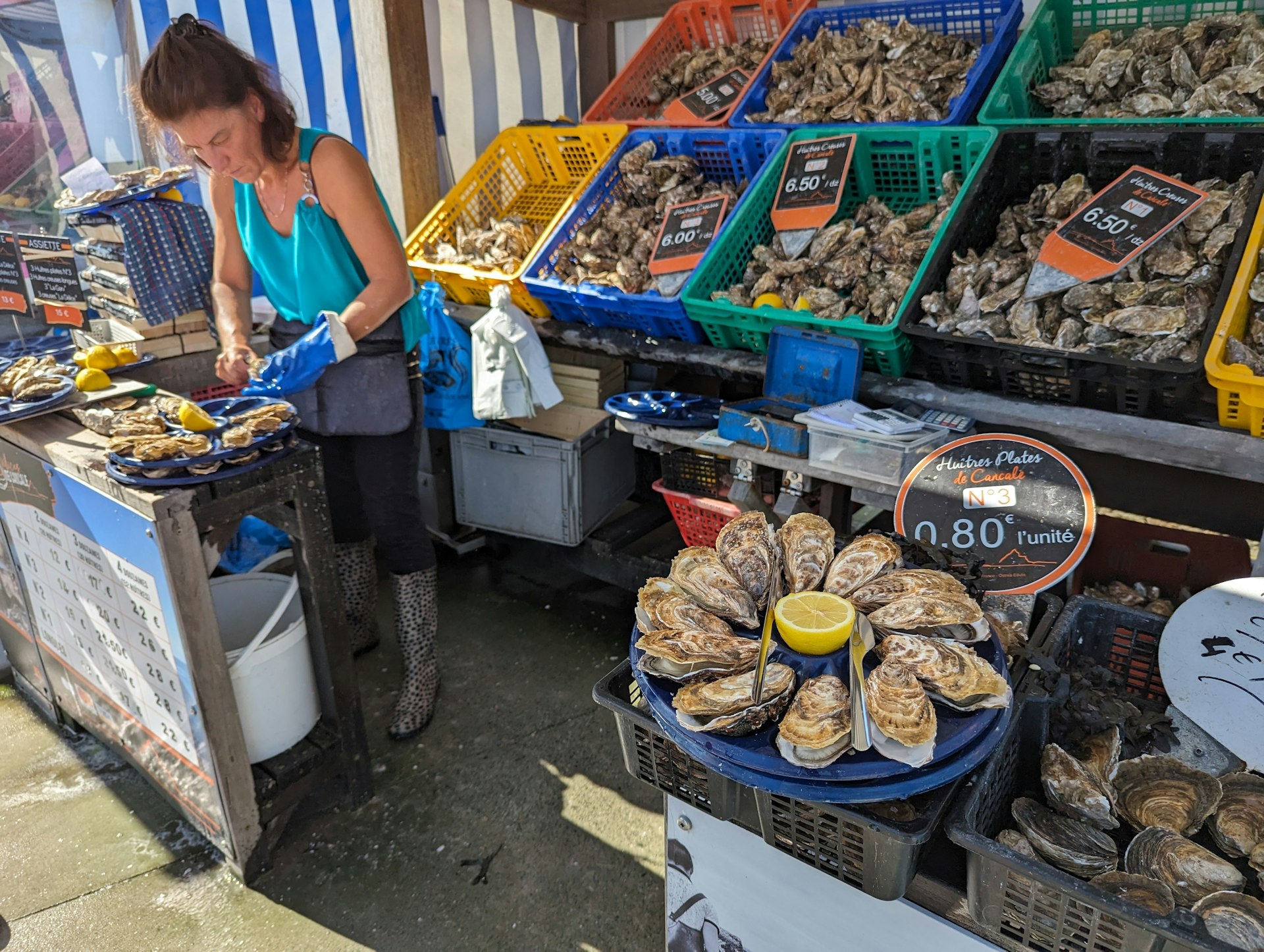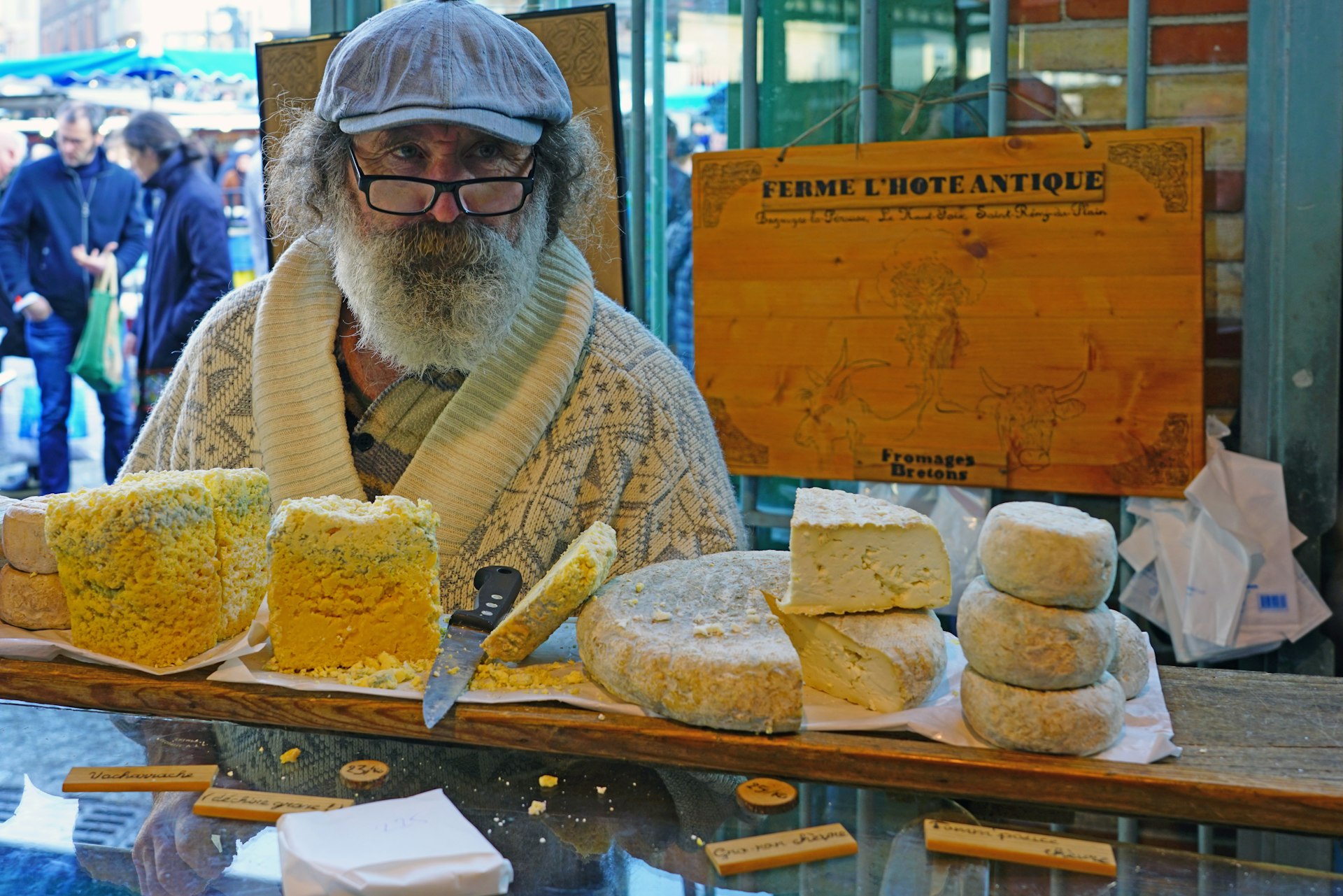Daphné Leprince-Ringuet literally wrote the book on Brittany – or at least the chapter on the region in the latest edition of Lonely Planet’s best-selling France guidebook.
The culinary heritage of Brittany is unique – and unmatched anywhere else in France.
After all, this northwestern region offers very few local cheeses and practically no wines (sacré bleu!); its eating culture instead revolves around crêpes. This type of pancake comes served with different toppings, and typical stone-walled crêperies abound in every city, town and village – the Brittany equivalent of the trattorias of Rome and the bistros of Paris. While the crêpe is simple, don’t mistake it for unsophisticated: crêpes are delicious and versatile, and will get you hooked in no time.
Brittany also stands out through its incredibly high-quality produce, ranging from freshly caught fish and shellfish to some of the country’s best pork. Dishes are often unvarnished, but almost always hearty and tasty – and sure to hit the spot every time.
1. Savor a galette complète
The variety of galettes – savory crêpes – on offer in most crêperie can be overwhelming; if in doubt, always go for the most classic combination. Whatever your mood, the complète – with egg, ham and cheese folded inside a light and crispy pancake – will do the trick. If you feel so inclined, you can always add some extras, such as onion compote or cooked mushrooms. Few Bretons frown on ordering a second helping.
Where to try it: The must-have galette complète is available at every single crêperie. Crêperie Saint-Guenhaël in Vannes and La Touline in St-Malo are good places to start.
2. Stuff yourself with a galette-saucisse
A twist on the traditionally flat galette, galette-saucisse consists of a grilled pork sausage wrapped in a pancake. While some purists disagree, it’s even better when stuffed with onion compote and mustard. A main staple of the street-food scene in the eastern parts of Brittany, it’s available on practically every corner of Rennes.
Where to try it: Every Saturday, the smell of galette-saucisse permeates Rennes’ marché des Lices.
3. Carnivores will rejoice in the kig ha farz
One of Brittany’s most monumental dishes, kig ha farz is not for vegetarians. Literally meaning “meat” (kig) and “stuffing” (farz), it bears some resemblance to the traditional pot-au-feu that can be found across the rest of France – and similarly finds its roots in poorer households and handed-down family cookbooks. Although recipes can vary, the dish usually consists of pork and beef stewed with vegetables and served with a pudding made of buckwheat flour (the same one that is used to make galettes). It typically comes served with lipig, a decadent buttery-onion-y sauce.
Where to try it: Kig ha farz is a regional dish that you’ll mostly find in the northwest of Brittany. Still largely kept to family kitchens, it can be hard to pin down in restaurants – though Le Restaurant Breton in St-Frégant has it on the menu every other Thursday.

4. Go big with a heaping seafood platter
Few places in Brittany are far from the sea, and the region’s close links to the maritime world are ubiquitous – with food no exception. Most parts of Brittany specialize in certain types of shellfish (I’m looking at you, Cancale oysters); these will usually come served as part of a majestic towering seafood platter that includes delicacies ranging from oysters to crab through prawns and lobster.
Where to try it: Ideally on a sunny terrasse facing the sea, such as Au Pied d’Cheval in Cancale.
5. Savor the sea with a cotriade
Marseille has the bouillabaisse; Brittany, the cotriade. A dish from Morbihan in the south of the region, cotriade is a stew made with lots of different types of local fish and shellfish. The meal has been historically cooked by fishermen, who would throw in anything and everything that hadn’t been sold for the day. Mussels, prawns, sardines, mackerel, sea bream and more are combined into a large pot together with vegetables, potatoes and herbs, then boiled in broth and white wine until it all comes together in a delicious, comforting, sea-flavored soup. A dish to be savored with warm bread and a dry white wine.
Where to try it: In Lorient, the restaurant Entre Terre et Mer offers an authentic cotriade.
6. Consider seaweed, served many ways
Brittany’s coast is Europe’s largest seaweed field, and about a dozen species are harvested to sell as edible products. Mostly produced in the northwest of the region, seaweed (algues) is a common addition to restaurant recipes, and you’ll find it on menus in the form of a side dish, or tartare; as a flavorful terrine; or sprinkled on top of your main course. In specialty shops, you’ll be able to buy seaweed-flavored biscuits and pasta, and even tea and beer. The taste can vary significantly: depending on the species, it can add a soft touch of salt, a little bitterness or a nutty aftertaste.
Where to try it: Ima in Rennes is a Japanese-French fusion restaurant that has made Breton seaweed a centerpiece of the menu.
7. Indulge in salted-butter caramel
Bretons feel very strongly about butter – namely, that it should always be salted. From this conviction has sprung one of the region’s most mouth-watering delicacies: salted-butter caramel, a thick, sweet, gooey sauce that is eaten most often as a crêpe topping. It’s also used to flavor cakes and ice cream, or simply to be enjoyed on its own.
Where to try it: Any self-respecting crêperie will have a crêpe caramel au beurre salé. Always make sure that the caramel is homemade; a safe spot to try it out is Crêperie Au Vieux Quimper in Quimper.

8. End on a sweet note with a kouign amann
With a name translating as “butter cake,” kouign amann is a straightforward treat. Not one to try if you’re already full, this sweet treat from Finistère consists of multiple layers of laminated dough packed with vast quantities of butter and sugar, and cooked at a low temperature to achieve perfect caramelization. You’ll also find it stuffed with salted-butter caramel or cooked apples for extra goodness. Once described as the “fattiest pastry” in Europe, it’s a must-have for anyone with a sweet tooth.
Where to try it: François Kouign Amann in Vannes is where you’ll find total sugar overload and a perfect level of gooeyness.
9. Dig into a far breton
Don’t let the unassuming aspect of the far breton fool you. Brittany’s specialty cake is similar to its better-known cousin, flan – yet denser and softer all at once, and made with salted butter (of course). You can have it as it is – but to get a taste of the real deal, try the traditional version, which is stuffed with prunes and flavored with rum.
Where to try it: You’ll find far breton in most bakeries in Brittany. A particularly tasty one is from A La Belle Meunière in St-Cast-le-Guildo, which last year placed first in a competition to determine the region’s best far.

10. Skip the wine, and taste Breton cider and lambig instead
If you’re heading to the crêperie, forget about wine: in Brittany, cider’s the stuff to quaff. You’ll be expected to eat your galettes and crêpes with a small bowl (or bolée) of tasty cidre breton. Strong or light, sweet or bitter, fruity or flowery: you’ll find immense variety of ciders on offer across the region, and it’s well-worth making your way to a cidrerie to find out more about local produce. Looking for something stronger to end the meal? You can also try lambig, a type of Breton brandy produced by distilling cider and aging the spirit in oak casks.
Where to try it: You won’t have to go out of your way to try local ciders: in bars and restaurants across Brittany, it’s almost always on the drinks menu. For a visit and a tasting at one of the region’s most respected producers, head to Manoir du Kinkiz near Quimper.
